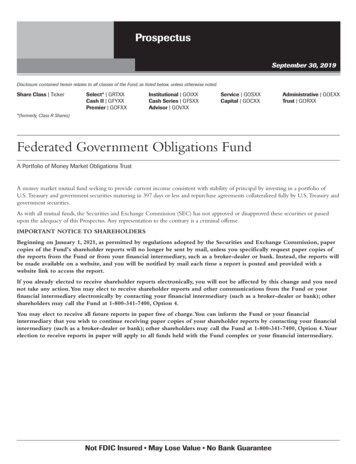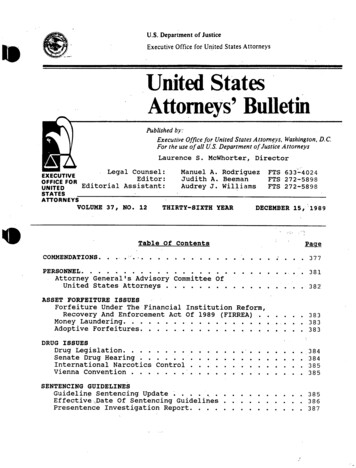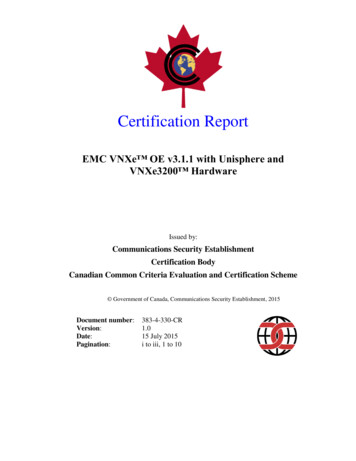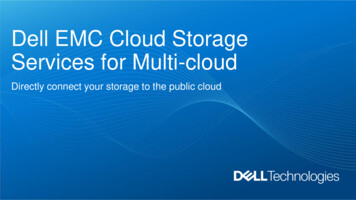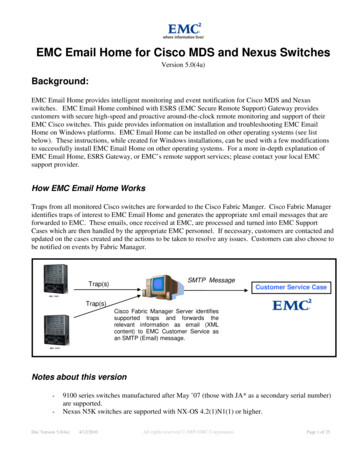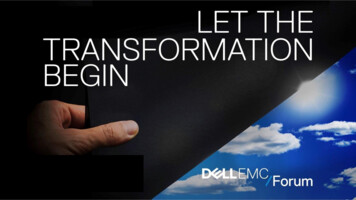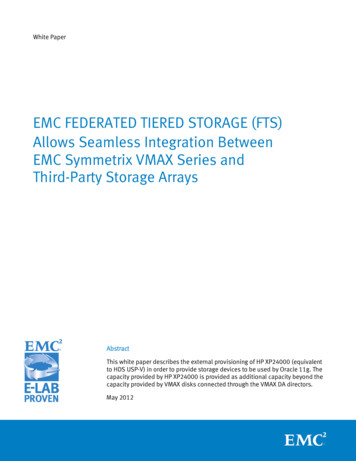
Transcription
White PaperEMC FEDERATED TIERED STORAGE (FTS)Allows Seamless Integration BetweenEMC Symmetrix VMAX Series andThird-Party Storage ArraysAbstractThis white paper describes the external provisioning of HP XP24000 (equivalentto HDS USP-V) in order to provide storage devices to be used by Oracle 11g. Thecapacity provided by HP XP24000 is provided as additional capacity beyond thecapacity provided by VMAX disks connected through the VMAX DA directors.May 2012
Copyright 2012 EMC Corporation. All Rights Reserved.EMC believes the information in this publication is accurate as of itspublication date. The information is subject to change without notice.The information in this publication is provided “as is.” EMC Corporation makesno representations or warranties of any kind with respect to the information inthis publication, and specifically disclaims implied warranties ofmerchantability or fitness for a particular purpose.Use, copying, and distribution of any EMC software described in thispublication requires an applicable software license.For the most up-to-date listing of EMC product names, see EMC CorporationTrademarks on EMC.com.All trademarks used herein are the property of their respective owners.Part Number H10698Federated Tiered Storage (FTS) Solution2
Table of contentsIntroduction . 4Purpose . 4Scope . 4Audience . 4Technology overview . 4FTS . 4Required Enginuity Components . 5Modes of Operation . 5Implementation . 6Configuring FTS . 6Tested configuration . 6Usage case . 7Host and storage configuration . 7Oracle . 10Conclusion . 12References . 12Federated Tiered Storage (FTS) Solution3
IntroductionWith the substantial increases in the amount of data stored, businesses continue tostrive for ways to leverage and extend the value of existing resources, reduce cost ofmanagement, and drive the best performance achievable in the environment. Addingto the challenge is the desire to ensure that data is kept on an appropriate storagetier so that it is available when needed but stored in as cost-effective andenvironmentally responsible a manner as possible.EMC Symmetrix Federated Tiered Storage (FTS) addresses many of these concernsby allowing existing qualified storage platforms to be used as physical disk space fora Symmetrix VMAX array. This allows IT organizations to manage diverse storageplatforms using proven and robust Symmetrix software and microcode features suchas EMC SRDF , TimeFinder , and Virtual Provisioning .Federated Tiered Storage (FTS) is a new feature of Enginuity 5876 that allowssupported, SAN-attached disk arrays to provide physical disk space for SymmetrixVMAX. This permits the user to manage, monitor, migrate, and replicate data residingon both Symmetrix and non-Symmetrix arrays using familiar EMC software andEnginuity features. This applies equally to data that already exists on external arraysas well as to new storage that is being allocated.FTS is designed to allow for seamless integration between various third- party storagearrays and the VMAX family of arrays by consolidating array views and reducing thenumber of physical connections from host to storage.This white paper describes the external provisioning of HP XP24000 (equivalent toHDS USP-V) in order to provide storage devices to be used by Oracle 11g. Thecapacity provided by HP XP24000 was provided as additional capacity beyond thecapacity provided by VMAX disks connected through the VMAX DA directors.PurposeThe purpose of this document is to provide an overview of some of the features of FTSand present a use case.ScopeThis document focuses on the encapsulation feature of FTS, specifically dealing withHP-UX running Oracle on HP XP storage arrays and presented through an EMC VMAX.AudienceThis document is intended for anyone seeking an overview of EMC FTS and looking foran example of a potential use case.Technology overviewFTSFederated Tiered Storage (FTS) allows LUNs that exist on external arrays to be used toprovide physical storage for Symmetrix VMAX. The external LUNs can be used as rawstorage space for the creation of Symmetrix devices in the same way internalSymmetrix physical drives are used. These devices are referred to as eDisks. Data onthe external LUNs can also be preserved and accessed through Symmetrix devices.This allows the use of Symmetrix Enginuity functionality such as local replication,remote replication, storage tiering, data management, and data migration with datathat resides on external arrays.Federated Tiered Storage (FTS) Solution4
Required EnginuityComponentsFTS is implemented entirely in Enginuity and does not require any additionalSymmetrix hardware. Connectivity with an external array will be established throughthe same fiber optic SLICs currently used for configuring FAs and RFs. Instead ofrunning FA or RF emulation, however, the processors will run a new type of emulation.DX directorsA new emulation, referred to as DX, (for DA eXternal) has been developed that adaptsthe traditional DA emulation model to act on external logical units as though theywere physical drives. The fact that a DX is using external LUNs instead of a DA usinginternal LUNs is transparent to other director emulations and to the Enginuityinfrastructure in general. With respect to most non-drive-specific Enginuity functions,a DX behaves the same as a DA.eDiskAn eDisk is a logical representation of an external LUN when it is added into the VMAXconfiguration. The terms eDisk and external spindle both refer to this external LUNonce it has been placed in an external disk group and a virtual RAID group.Virtual RAID groupAn unprotected, virtual RAID group gets created for each eDisk that gets added to thesystem. The RAID group is virtual because eDisks are not protected locally by theVMAX; they rely on the protection provided by the external array.Modes ofOperationFTS has two modes of operation depending on whether the external LUN will be usedas raw storage space or has data that must be preserved and accessed through aVMAX volume.External Provisioning — Allows the user to access LUNs existing on external storageas raw capacity for new Symmetrix devices. These devices are called externallyprovisioned devices and are used in the same way that an internal Symmetrixphysical drive is used. New Symmetrix volumes are created from external storageusing disk groups containing external LUNs that, when configured for FTS, are calledeDisks.Encapsulation — Allows the user to preserve existing data on external LUNs andaccess it through Symmetrix volumes. These devices are called encapsulateddevices. The encapsulation process configures external LUNs as eDisks but preservesany data that exists on them. It also creates associated Symmetrix volumes throughwhich to access the data on the eDisk. There are two different options withencapsulation, each briefly discussed next.Standard encapsulationThe external spindle is created and added to the specified external disk group andunprotected RAID group. Symmetrix devices are also created at the same time,allowing access to the data that has been preserved on the external LUN.Virtual Provisioning encapsulationJust as with Standard encapsulation, the external spindle is created and added to thespecified external disk group and to an unprotected RAID group. Data devices (TDATs)are then created and added to a specified thin pool. Fully, non-persistently allocatedthin devices (TDEVs) are also created and bound to the pool. Extents are allocated tothe external LUN through the TDAT.Federated Tiered Storage (FTS) Solution5
ImplementationPrior to encapsulating third-party array volumes through the VMAX, the external arraymust be physically connected to the VMAX. This is accomplished by connecting VMAXDX ports to the external array front end Fibre Channel (FC) ports through the SAN. DX,(DA eXternal), is a new emulation that allows Fibre Channel directors to function likeDAs. DX directors use the same Fibre Channel boards that run FA or RF emulation.Once the DX directors have been configured and are properly zoned to the externalarray storage ports, devices presented on those external ports are available to beadded as eDisks for external provisioning or for encapsulation. In this paper, thedevices contain an Oracle database that needs to be preserved, so the external LUNswill be encapsulated as eDisks.Once this is done, the Symmetrix volumes created as part of the encapsulationprocess can be presented to a host through the VMAX and will contain the exact samedata that existed on the LUN before encapsulation. Encapsulation allows the user toeasily integrate a third-party array and data into a VMAX environment and performsimple VLUN migrations from encapsulated third-party volumes to native VMAXvolumes.Configuring FTSHosts that were accessing an Oracle database on HDS storage volumes were movedto the VMAX and the HDS volumes were presented to the DX ports and encapsulatedusing FTS. The HDS data was then available to the hosts through the VMAX volumesand eDisks that were created during the encapsulation operation. The VMAX volumeswere then mapped and masked to the hosts via standard VMAX masking andmapping procedures, giving the hosts access to the original data, even though theyare connected only to the VMAX.For an in-depth description of FTS, along with implementation details and examples ofFTS operations, refer to Design and Implementation Best Practices for EMC SymmetrixFederated Tiered Storage (FTS) Technical Notes, available athttp://powerlink.emc.com.TestedconfigurationEMC E-Lab tested the following configuration.Arrays EMC VMAX 40K array running EMC Enginuity 5876 code HDS-UPS arrayPrimary host HPUX 11iV3 with EMC PowerPath , MPIO, and DMPSecondary hosts Windows 2K3 with PP 5.5 Windows 2K8 with DMP ESXi 5.0 with PP/VE 5.7 ESX 4.1 with native MP Solaris 10 with PP Solaris 11 with MPxIO AIX 6.1 with MPIO and PowerPathFederated Tiered Storage (FTS) Solution6
RHEL 6.2 with PPSLES 11 SP2 with native MPHPUX 11iv2 with PP, DMP, and pvLinksUsage caseHPUX XP24K as externally provisioned devices for Oracle Enterprise Manager 11G.Host and storageconfigurationFirst the hosts were zoned with the HDS storage array and volumes were assigned toeach host WWN. Once the hosts had volumes assigned and could access them, thehosts were moved to the VMAX 40K and the volumes were assigned to FTS, as shownin Figure 1.Figure 1.Host and storage configurationThe symsan command provides the list of the HP XP24K Port WWN that is externallyencapsulated through DX dir 7F and port 0, as shown in Figure 2.Federated Tiered Storage (FTS) Solution7
C:\ symsan -sid 453 list -sanports -DX 7F -port 0Symmetrix ID: 000195700453FlagsDIR:PIVendor----- ----- ------------07F:0.HP07F:0.HPNumArrayLUNs Remote Port WWN---------------- ---- --------------------000000000000000012 50060E8005426D05000000000000000012 50060E8005426D01Legend:Flags: (I)ncomplete : X record is incomplete, . record iscomplete.Figure 2.symsan commandThe symsan command displays the list of the LUNs that are provisioned as tieredLUN to VMAX 40K HK000195700453. Each HP XP 24K LUN is displayed with itscorresponding WWUID, as shown in Figure 3.C:\ symsan list -sanluns -sid 453 -DX 7F -port 0 -wwn 50060E8005426D05Symmetrix ID:Remote Port 045350060E8005426D05Flags BlockCapacityLUNDev LUNICRTHS Size(MB)NumNum WWN------- ----- ----------- ----- ----- -------------------------------X.F.5121024000N/A 24000N/A 24000N/A 24000N/A 00000N/A 00000N/A 00000N/A 20000N/A 20000N/A 20000N/A 24000N/A 24000N/A ags: mmetrix::::::XXXAXXFigure 3. record is incomplete, . record is complete.record is controller, . record is not controller.record is reserved, . record is not reserved.AS400, F FBA, C CKD, . Unknownrecord is a thin dev, . record is not a thin dev.Symmetrix device, . not Symmetrix device.List of LUNsFederated Tiered Storage (FTS) Solution8
The symdisk command provides the corresponding VMAX 40K devices that arerelated to the external HP LUN. Note that these VMAX 40K devices are externallyprovisioned and available as extra capacity as long as they were mapped to HP hosts,as shown in Figure 4.C:\ symdisk -sid 453 show -wwn 5235303020303030313730303530303233303420Symmetrix IDDirectorInterfaceTarget IDSpindle IDExternal WWNDisk Group NumberDisk Group NameDisk LocationTechnologySpeed (RPM)Form 03020303030313730303530303233303420512DISK GROUP 512ExternalN/AN/AN/AVendor IDProduct IDProduct RevisionSerial ID::::EMC CorpN/AN/AN/ADisk BlocksBlock SizeActual Disk BlocksTotal Disk Capacity (MB)Free Disk Capacity (MB)Actual Disk Capacity (MB)Rated Disk Capacity /ASpare DiskSpare CoverageEncapsulatedDisk Service State::::FalseN/AFalseNormalHypers (3):{#VolEmulation--- ----- ---------------1 N/AFBA2 N/AFBA3 N/AFBA}Figure 4.Dev---03A503B103BDTypeMir Mbr StatusCap(MB)------------- --- --- -------------- -------Ext-Data11 Ready28776Ext-Data11 Ready28776Ext-Data11 Ready28776symdisk commandFederated Tiered Storage (FTS) Solution9
The symdisk command displays the assignment of the new disk group ID 512 to theexternally provisioned VMAX 40K devices, as shown in Figure 5.C:\ symdisk list -dskgrp summary -external -sid 453Symmetrix ID: 000195700453Disk GroupDiskCapacity---------------------- ----------------------- -------------------------------Flgs Speed SizeTotalFreeActualNum NameCnt LT (RPM) (MB)(MB)(MB)(MB)---------------------- ----------------------- -------------------------------512 DISK GROUP 512Total12X-N/AN/A12204031844801220403---------- ---------- ---------12204031844801220403Legend:Disk (L)ocation:I Internal, X External(T)echnology:S SATA, F Fibre Channel, E Enterprise Flash Drive, - N/AFigure 5.OracleAssignment of new disk group IDOracle Enterprise Manager 11G was then configured on the encapsulated volumes, asshown in Figure 6, Figure 7, and Figure 8.Figure 6.Oracle Database configurationFederated Tiered Storage (FTS) Solution10
Figure 7.Oracle Database propertiesFigure 8.Oracle Database volumesFederated Tiered Storage (FTS) Solution11
The host was then able to access the database transparently with no side effects fromthe encapsulation, as shown in Figure 9.Figure 9.Host has transparent access to databaseConclusionIn conclusion, EMC E-Lab testing confirmed that an Oracle database can run on an HPXPS array and present those volumes, via encapsulation, to a host through an EMCSymmetrix VMAX array. The host is able to have transparent access to the original XPSstorage volumes that have a physical connection to the XPS storage array. Thisreduced the number of physical connections from host to storage.ReferencesFTS documentation can be found on http://powelink,emc.com, including: Design and Implementation Best Practices for EMC Symmetrix Federated TieredStorage (FTS) Technical NotesFederated Tiered Storage (FTS) Solution12
EMC VMAX 40K array running EMC Enginuity 5876 code . hosts were moved to the VMAX 40K and the volumes were assigned to FTS , as shown in . Figure 1. Figure 1. Host and storage configuration The symsan command provides the list of the HP XP24K Port WWN that is externally

